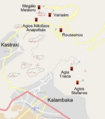Meteora facts for kids
Quick facts for kids Metéora * |
|
|---|---|
 |
|
| Country | |
| Type | Mixed |
| Criteria | i, ii, iv, v, vii |
| Reference | 455 |
| Region ** | Europe |
| Coordinates | 39°42′N 21°37′E / 39.700°N 21.617°E |
| Inscription history | |
| Inscription | 1988 (12th Session) |
|
|
The Metéora (which means "suspended rocks" or "in the heavens above" in Greek) is a truly amazing place in Greece. It's famous for its many monasteries that are built high up on huge, natural sandstone rock pillars. Imagine buildings perched on top of giant stone fingers reaching for the sky! This incredible site is located near the town of Kalambaka in central Greece.
Metéora is home to six Eastern Orthodox monasteries. It is almost as important as Mount Athos, another very significant religious site in Greece. Because of its unique natural beauty and historical importance, Metéora is listed as a UNESCO World Heritage Site.
Contents
What Makes Meteora So Special?
Metéora is unique because of its incredible natural landscape. The monasteries are built on tall, steep rock formations. These rocks were formed millions of years ago by rivers and earthquakes. Over time, wind and rain shaped them into the giant pillars we see today.
The name "Metéora" perfectly describes these monasteries, as they truly look like they are "suspended in the air." This makes them very hard to reach, which was important for the monks who wanted to live peaceful lives away from the busy world.
The Monasteries of Meteora
Today, there are six active monasteries at Metéora. These are:
- The Great Meteoron Monastery
- The Monastery of Varlaam
- The Monastery of Rousanou
- The Monastery of St. Nicholas Anapausas
- The Monastery of the Holy Trinity
- The Monastery of St. Stephen
In the past, there were many more monasteries, possibly as many as twenty-four! Over centuries, some were abandoned or fell into ruin. The ones that remain are still active religious communities, welcoming visitors from all over the world.
Life in the Monasteries
Life in the monasteries has always been focused on prayer, study, and simple living. The monks and nuns dedicate their lives to their faith. They grow their own food, maintain the buildings, and welcome pilgrims.
Getting supplies to these high-up monasteries used to be very difficult. People would use nets pulled by ropes or long, shaky ladders. It was a dangerous journey! Today, there are roads and stairs carved into the rocks, making it much easier for visitors to explore these ancient sites.
A UNESCO World Heritage Site
In 1988, Metéora was recognized by UNESCO as a World Heritage Site. This means it's considered a very important place for everyone in the world to protect and enjoy. It was chosen for several reasons, including:
- Its amazing natural beauty (Criteria VII).
- Its unique artistic and architectural achievements (Criteria I and IV).
- Its importance in human history and culture (Criteria II and V).
Being a World Heritage Site helps ensure that Metéora's natural beauty and its historic monasteries are preserved for future generations.
Images for kids
See also
 In Spanish: Meteora para niños
In Spanish: Meteora para niños













